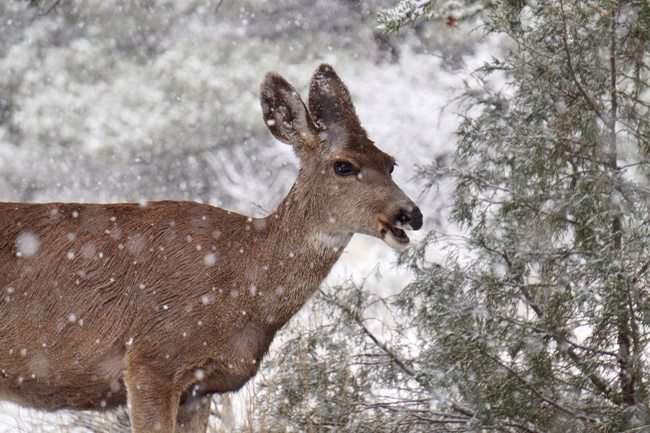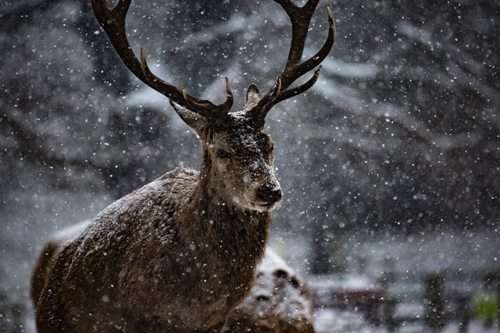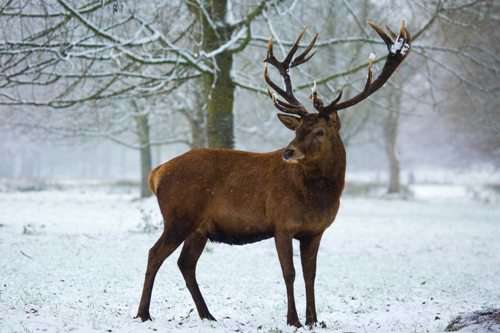Although wild animals have an extraordinary ability to survive in severe conditions, many still need a lot of calories to keep warm throughout winter. It’s impossible to complete this mission when winter comes, so they tend to conserve sooner before the winter months with lots of food.
In this post, we will explain to you “What do deer eat in the winter?” as a specific example of wildlife’s winter surviving activity. Please read carefully to gain more information and (in case) prepare for your bow hunt.

Contents
What Do Deer Eat In The Winter? – Different Types Of Deer And Their Food
Now, let’s get into the topic and learn about deer’s food choices in the winter. There are different types of deer with their different preferred types of food.
Whitetail Deer
When whitetail deer search for their food from fields or food plots, cowpeas, soybeans or corn on the snow or ground is their first choice. Besides, picking food from vertical stalks is not in whitetail deer’s interest. Indeed, you can easily see them walk and pay no attention to many standing crops’ rows and spend time looking for food on harvested lands.
Farmers can use a truck or ATV to chop down some crop rows every two to three days, then offer the deer different locations for their meals to reduce the risks of diseases.
Woody Browse
When winter comes, finding food sources is very hard for deer. In this case, they prefer to eat woody browsers. This ingredient makes up to 80% – the largest in their diet. Woody browser contains different materials in each geographical location, but in general, it has leaves, twigs and buds.
Deer love finding meals in young forests as they offer higher-quality vegetation. Whitetail deer search for maple trees’ buds, white cedar, white pine, yellow birch and sumac. Moreover, there is also another standard browse like grapevines, honeysuckle, greenbrier, hackberry, oak and elm.
If deer have a tough time seeking these meals, leaves are the next best choice, and they even eat the dead ones on the ground.
Mast
Berries, pears, apples and acorns are plant fruits, and we call them “mast”. The whitetails consider mast as their seasonal food source. They use their hind legs to stand up and reach them on the trees to eat the winter apples.
Acorns fall from the oak trees during the autumn and lie on the ground until the winter. Deer will find and eat them, and they really like the acorns as they are rich in fats and carbohydrates.
Corn
Corn is also a favourite meal for the whitetail deer since it loads high calories with fat and carbohydrates. If you want to find the whitetails, search in the cornland. There are some different ways deer eat corn in their diet. Before winter comes, farmers normally harvest their corn, and there are some leftovers for the deer to graze.
Brassica Blend
Brassica blend belongs to the mustard family and is a lush forage. You can use this ingredient to target the whitetails in the late season. This food plot mix is quite popular as they are high in protein, easy to grow and a low-budget plant. Moreover, they have different varieties and grow very fast.
There is a brassica family’ member – rape (from grapes). This plant can survive miraculously in cold conditions and offer deer quality meals. Besides, cauliflower, cabbage, canola, turnip, radish and kale are also common brassica in the whitetail deer’s meals.

Forest Deer
With forest deer or big-woods deer they tend to not engage in activities in late winter and have a low metabolism. However, their basic needs of energy are often higher than the nutrition they get from woody browse like red osier dogwood, hazelwood, maple, aspen, hemlock, ash’s buds and twigs.
White cedar is the only woody browse that can help deer survive in one hundred days in a deer yard, but they need up to three to six pounds of this ingredient each day.
There’s another popular item – grey arboreal lichens or “Old Man’s Beard” in forest deer’s winter menu. They are part fungus and algae and have quite the same features as the Spanish moss.
Deer often find these lichens on dying or dead balsam trees and spruce. They enjoy this plant because of the rich nutrition. Moreover, thanks to the micronutrients from these lichens, surviving through many tough winter months is easier for deer.
How Deer Survive Winter With Food?

Deer will prepare for their winter meals in autumn as the mission is quite impossible in the winter. Among many fat ingredients, the acorn is the ideal choice for deer to increase their weight. However, eating is not the only way to get more fat layers in their body.
Another way to survive winter is to use the weight response – a simple adaptation for the harsh condition. In this case, they will prepare for the cold weather by converting all the food they consume into fat, no matter how good the nutrition’s quality inside their body is.
How Can Hunters Find Deer By Using The Food?

One of the crucial things to understand as a hunter is that deer enjoy sleeping near their favourite food sources to save more necessary energy. As a result, they can go further in their journey during the day.
If you want to find deer, you should search in the areas with thick bedding cover near the food sources. The densest places that guarantee you deer are places like a forest full of blackberry branches, grapevines, prickly ash or cedar bottoms with big woods.
These woodlands are sanctuaries with thick covers for deer to be safe from cold wind and get away from human hunting activities. Therefore, many hunters always pick these places first in their hunting days.
Because deer enjoy finding meals in the wide and different areas frequently, their meals change depending on the availability of the ingredients. Hence, another tip for you is to search near their food source if you want to find the whitetails.
Besides, baits are also very important. However, there are still some debates among hunters about the best materials for making food plots to attract deer – brassicas, soybeans or corn?
To many, corn is the least beneficial ingredient to hunt deer since they are so common and easy to grow. Thus, keep that in mind before choosing the material to make a food plot for your hunting preparation.
If you are using an deer rifle, you should choose for your rifle the best scope for deer hunting.
Conclusion
And this is the end of our post today. Hopefully, we helped you learn everything in detail about “What do deer eat in the winter?”. No matter what your purposes are, either researching deer eating habitat or preparing for your hunting times, we believe you are well prepared.

I am Jerry Gonzalez, and my heart beats for the great outdoors, especially in the breathtaking landscapes of Helena, Montana. Engaging with fellow enthusiasts online and at local hunting clubs has been a rewarding experience, and I find great joy in sharing knowledge and experiences with like-minded individuals. My goal is to empower my fellow hunters with well-informed choices, regardless of their experience level.
